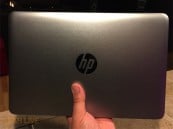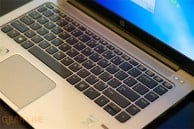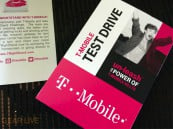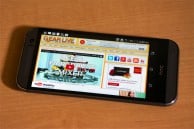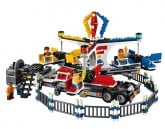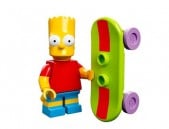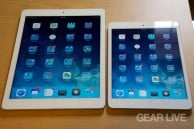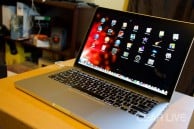Find Our Latest Video Reviews on YouTube!
If you want to stay on top of all of our video reviews of the latest tech, be sure to check out and subscribe to the Gear Live YouTube channel, hosted by Andru Edwards! It’s free!
Thursday November 17, 2011 4:04 pm
Amazon Kindle Fire review
The Amazon Kindle Fire is the first small tablet that average users can pick up and immediately use, with a simple, clear interface. Then there's the price: Android along with amazing specs for just $199. It's open enough to attract geeks, too. While the user interface occasionally gets sluggish, we're willing to have a bit of patience to get a first-rate tablet for half of what most competitors charge, thus the Kindle Fire is our first Editors' Choice for small tablets.
Design
A solid little brick at 7.5 by 4.7 by .45 inches and 14.6 ounces, the Kindle Fire looks and feels a lot like the BlackBerry PlayBook, but the Fire is smaller in all dimensions. There are no slots or tabs; both the memory and battery are sealed in, and the only interruptions in its smooth, black form are the headphone jack, Power button, MicroUSB jack, and dual stereo speakers. There's no camera, but I've never been sold on the value of tablet cameras anyway. It uses 802.11b/g/n Wi-Fi networks to get online; there's no cellular radio or Bluetooth connectivity.
Turn the Fire on and the 7-inch 1024-by-600 IPS LCD screen lights up. This display is very sharp and clear, but it's also rather reflective. Just like on the Apple iPad 2, you may have trouble reading in bright light because of the screen's sometimes mirror-like gloss. While this is par for the course with tablets, I expected more given the Kindle name. This isn't a dedicated e-reader by any means.
OS and Content
The Kindle Fire packs a dual-core, 1GHz TI OMAP4 processor and runs a very highly customized version of Android 2.3.4 (Gingerbread). The customization is really good news for non-geeks. Android is a delightfully open-ended OS, but it's too open-ended for a lot of people; it's not immediately clear what you're supposed to do with an Android tablet.
It's immediately clear what to do with the Kindle Fire, though. Start it up and you see seven words: Newsstand, Books, Music, Video, Docs, Apps, and Web. That's what you do. Most of the rest of the home screen is devoted to a Cover Flow-like carousel of your most recently used content, with four user-assignable favorites at the bottom.
Each of the seven sections gives you a virtual "bookshelf" of items stored on your Fire along with a link to Amazon's relevant store. Yes, this tablet is designed to make you buy stuff from Amazon. You don't have to—you can load your own files—but it's very, very easy to buy and arrange items from Amazon's many digital shops. And that's great.
Most people are familiar with Kindle books, which read and sync well on the Fire (although they don't have some of the new Kindle Touch features, like X-Ray summaries.) There are some new kinds of content in the bookstore for Amazon too, like color childrens books, for example. But they show up in landscape format. They look like straight flatbed scans, and you can't zoom in or out and there's no text-to-speech support there. That's a less appealing experience than you get on the Nook, at least for now.
The color screen makes comics look very appealing, although Amazon is still working out how to sell them; the Comixology app, and single issues of various comics, weren't available during my test period. In comics, you can double-tap to zoom in on individual panels, but you can't pinch-to-zoom. Two-page spreads end up segmented and zoomed.
Magazines are a mixed bag. You get two kinds: text-only magazines, which basically look like WAP sites or older Kindle documents, and "replica" magazines, which let you flip between images of magazine pages and the text of the articles. Newspapers give you what looks like a downloadable version of the paper's mobile Web site. Amazon has said that it doesn't intend to host replica newspapers.
The Music option lets you stream songs from your Amazon Cloud Drive or play files stored on the device. To get them onto your tablet, you can buy them from the Amazon MP3 store, or drag and drop or sync them from your PC. The Kindle Fire comes with free, unlimited cloud storage for anything you buy from Amazon. You can store non-Amazon files, too, but you only get 5GB; upgrading to 20GB costs $20 per year.
That cloud storage is very important. With only 6.5GB of free, onboard storage, you can only store three or four movies and some choice playlists on the tablet at a time. Everything else resides in the cloud locker, and you swap items in and out when you need more room.
Video lets you rent, buy or download movies or TV shows, or play Amazon Prime's subscription streaming video service. Docs lets you view documents you've sent to the Kindle's dedicated email address. Apps shows the apps you've downloaded from Amazon's app store or sideloaded onto the tablet, and Web loads the Silk browser.
I also played my own media. The Kindle Fire handles MP3, AAC, and OGG music, including album art. For video, it plays H.264 and MPEG4 only, at resolutions up to 1080p. There's no Bluetooth stereo support, HDMI out, or way to connect the Kindle to a TV; Amazon would rather you play its cloud content through an Amazon-enabled set-top box like a TiVo.
I got 4 hours, 55 minutes of continuous video playback on the Kindle Fire. That's longer than our favorite small Honeycomb tablet, the Acer Iconia Tab A100, but shorter than other Gingerbread-based tablets we've tested, like the Velocity Micro Cruz T408.
Apps and Appstore
We have dinged tablets before (and will continue to do so) for not supporting Google's Android Market, but I find Amazon's app store, when supplemented with Amazon's other downloadable services, a well-curated replacement. Amazon's app store will have "thousands" of Kindle Fire apps at launch, the company has said, and I found a strong array of popular apps. Angry Birds, Rhapsody, Pandora, Netflix, MLB At Bat, and QuickOffice are all represented, for instance. A few apps I looked for, like Opera Mobile, weren't there, but there's another way to get apps onto the device.
This is still Android, and this tablet isn't locked down. Plug the Kindle Fire into a PC or Mac and it pops up as a disk drive; you can drag and drop files into the 6.5GB of available memory at will. For the tech-savvy, it's a simple task to extract any APK program file from an Android phone and drop it onto the Fire. Amazon's app store includes the free Easy Installer, which lets you then install those apps on the Fire.
I installed a dozen free and paid apps from my HTC Sensation 4G phone. Cut The Rope, YouTube, the New York Times app, and Google Maps all worked fine. The Gmail app and the official Facebook app (which I sideloaded) both crashed and wouldn't run during my test period. Amazon hasn't yet expressed any problem with users rooting this device, so hack away.
Curiously, the Barnes & Noble Nook Android app runs beautifully if you prefer that store's book selection, although it can't download or read books that are restricted to the actual Nook tablets like most childrens books.
Silk Web Browser and Productivity
The Kindle's Silk Web browser is a new kind of browser which leverages Amazon's EC2 servers to speed up Web page loads. It requires a bunch of people to be using it so it can predict behavior, though, so during my tests, before the Fire was available, page loads were unenhanced. I got page load times that averaged double those on the Apple iPad 2 (14 seconds as opposed to seven), and that were slightly slower than the Samsung Galaxy Tab 7.0 Plus with Android Honeycomb and an HTC Sensation phone running Android Gingerbread.
The quality of pages, on the other hand, is very high. The Silk browser supports Flash and displays full desktop Web pages; you can flip between pages with tabs, and bookmark pages to pin to your home screen. Although the browser doesn't automatically reformat zoomed columns to avoid horizontal scrolling, double-tapping on a column of text zooms that column to the width of the screen. Java, Javascript, and Flash all displayed well, except for elements like sliders that require you to click and drag. I couldn't figure out how to drag something within a Web page.
The Kindle Fire doesn't come with a range of productivity apps, but that doesn't mean you can't be productive with it. You just have to download the relevant apps.
You get a basic POP/IMAP email program, a very simple contacts program, and the Docs reader, which can turn Office documents into Kindle-readable versions. Fortunately, better alternatives to everything are available in Amazon's app store. Want to edit office documents? Quickoffice Pro and Documents To Go are $15 each. Exchange email? NitroDesk's TouchDown costs $20. Like to draw? Autodesk SketchBook is $4.99. The app store has several Twitter clients, but not an official Facebook client. Typing on the Fire's two soft keyboards is fine, and there's the usual auto-correct.
Bugs And Other Discontents
The Kindle Fire has some bugs. That's to be expected; it's the first of its kind. The most irritating is the tablet's occasional sluggishness. Sometimes touch buttons just don't react. I had to stab the back button a few times during my tests, and flipping pages on heavily graphic comics isn't entirely seamless. I had occasional problems bringing up the navigation in magazines, but realized that if you drag your finger when you're tapping, even by a little bit, the nav doesn't come up. That's frustratingly picky.
If you grab a sleeping Kindle Fire to use the browser, you'll also discover another minor bug. The Fire disconnects from Wi-Fi while it's asleep. You can wake the tablet up and flip to the browser before it has automatically reconnected to the network, throwing an error. The error implies that you don't have a Wi-Fi connection, which isn't true; what the tablet means is that it needs another few seconds to lock in the Wi-Fi.
Overall, though? Pretty great for a $200 tablet.
Conclusions
The Kindle Fire is one of a kind, at least this week. It's the first affordable, easy-to-use general-purpose tablet. It doesn't replace the Apple iPad: It complements the iPad, which is bigger, more powerful, more expensive, and has far more apps. While there are other good small tablets out there, most notably the Acer Iconia Tab A100, they're also more expensive and just more fiddly. While geeks have more options with a "generic" Honeycomb tablet, non-geeks get less guidance as to what to do with them.
I can't emphasize this "ease of use" thing enough. More than anything else, that's what's been holding non-iPad tablets back. Amazon cracked it. End of story.
Yes, the Kindle Fire is missing features that will make some people scream. It has no camera, no Bluetooth, and no microphone. And if you don't get your videos from Amazon, you'll find storage very limited. But Amazon has correctly identified the features most people use, and pared away the rest to cut costs. Folks looking for those extra features can still turn to Acer's excellent Honeycomb tablet.
The Fire's top competitor is the forthcoming Barnes & Noble Nook Tablet, which we haven't tested yet. The Nook costs $50 more; for that you get double the storage, a microphone, and an SD memory card slot that lets you add another 32GB. But for most consumers, I suspect the decision is going to rest on content. Amazon has a superior library of apps. The Nook is better for reading childrens books, with more interactivity and read-along options. Amazon has music and video stores, and the Nook doesn't. Both tablets have Netflix and Hulu Plus. Both tablets make other tablets in their price range, like the Pandigital SuperNova look vastly inferior.
It's hard to make the Kindle/Nook decision without reviewing the Nook, but here goes. The Kindle has enough storage—especially with Amazon's Cloud Drive and focus on video streaming—along with better app and media stores and a lower price. I feel safe awarding it our Editors' Choice for small tablets. If the Nook lives up to its promise, it will also be a great tablet, and may get the same rating. But the Kindle Fire will still be a winner, if not the only winner, for this holiday season.
You can get the Kindle Fire now for $199.





